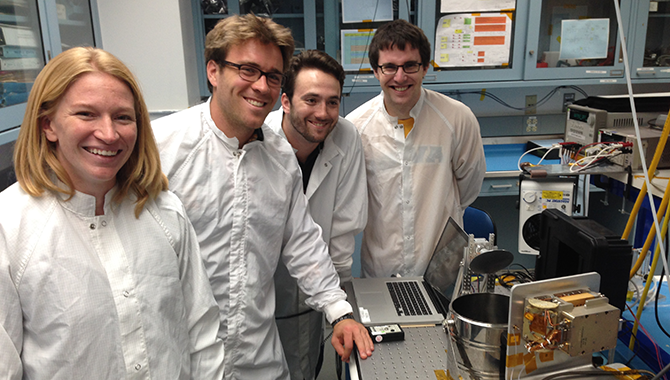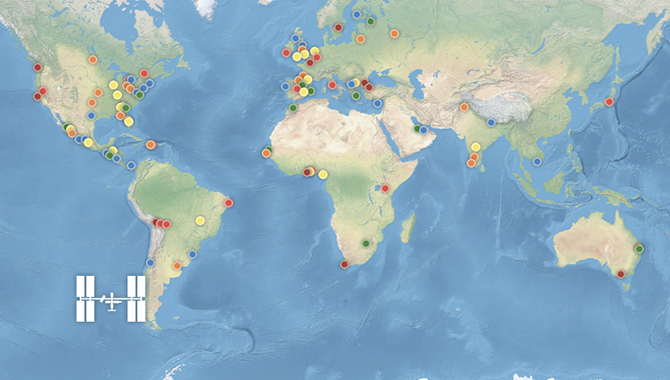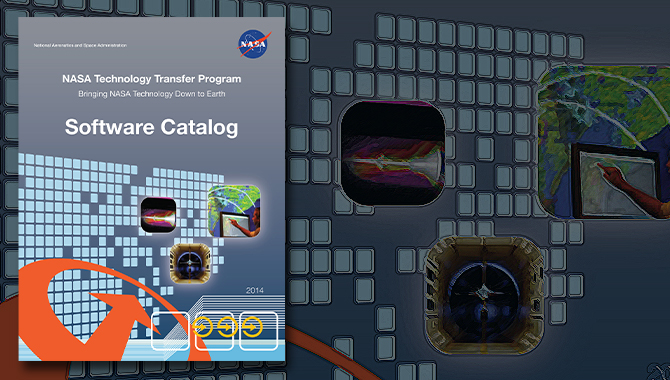
Several tiny CubeSat satellites are shown in this image photographed by an Expedition 33 crew member on the International Space Station on 4 October 2012. The satellites were released outside the Kibo laboratory using a Small Satellite Orbital Deployer attached to the Japanese module’s robotic arm. Japan Aerospace Exploration Agency astronaut Aki Hoshide, flight engineer, set up the satellite deployment gear inside the laboratory and placed it in the Kibo airlock. The Japanese robotic arm then grappled the deployment system and its satellites from the airlock for deployment. A portion of the station’s solar array panels and a blue and white part of the earth provide the backdrop for the scene.
Featured Image Credit: NASA/MSFC
By Glen A. Robertson, David T. Young, and John D. Sprague
Small satellites provide opportunities to pursue space exploration challenges through mass collaboration—enabling many minds to solve tough problems using small platforms.
NASA’s mission portfolio supports many small satellite and nanosatellite programs, which have advanced applications in science, exploration, technology development, space operations, and education. The Small Spacecraft Technology Program, sponsored by NASA’s Space Technology Mission Directorate, develops and demonstrates new capabilities of small spacecraft. These include a unique category of nanosatellites called CubeSats, which come in specific, standardized dimensions. One CubeSat unit (1U) measures 10cm by 10cm by 10 cm. Typically built in sizes ranging from 1U to 6U, their small size and weight make them ideal candidates to hitch a ride into space as secondary payloads. CubeSats are not limited to Earth-orbiting satellites; they can also include interplanetary spacecraft, planetary re-entry vehicles, and landing craft.
Over the past decade, NASA has used CubeSats for low-cost technology development, or pathfinder missions. For instance, the CubeSat Launch Initiative (CSLI), sponsored by NASA’s Human Exploration and Operations Mission Directorate, provides opportunities for small satellite payloads to fly on upcoming launches for previously planned missions. (See a map of CubeSat projects selected to date.) The program offers educational opportunities for students, teachers, and faculty to assist in attracting and retaining students in science, technology, engineering, and mathematics (STEM) disciplines, while promoting and developing innovative technology partnerships among NASA, U.S. industry, and other sectors.
At the same time that the CubeSat revolution has taken off, there has also been a growth in mass collaboration events. Typically defined as mechanisms that bring together many individuals to collaboratively solve a problem or challenge, mass collaboration events have increased in number and variety as information technology has made it possible to connect people from around the world in unprecedented ways. The recent application of the mass collaboration approach to CubeSat platforms is opening up a new range of possibilities for space exploration.
Mass Collaboration and SmallSat Clusters
Mass collaboration techniques have enhanced the design and development process for small satellite missions. For instance, CubeSats launched together on one vehicle face common design problems related to the loads and environment they experience. Solutions to these problems like shared launch platforms and interfaces are best worked out in a collaborative environment, where tools and techniques can be perfected rapidly and shared, and new ones will likely emerge along with new concepts and capabilities as larger, more diverse communities of developers are formed.
More recently, mass collaboration approaches have been applied to SmallSat cluster development, where teams create individual SmallSats that interact with one another to accomplish a common goal. Examples of tasks well suited to a SmallSat cluster approach include the recent Gravity Recovery and Interior Laboratory (GRAIL) mission, where two spacecraft orbiting Earth’s moon flew in formation and shared data; and the Edison Demonstration of SmallSat Networks (EDSN) mission, which will launch a loose formation of eight CubeSats into orbit approximately 500 km above Earth in order to make distributed, multipoint space radiation measurements.
Future concepts for cluster missions may include a demonstration of a communication-based deep space navigation network, proposed by Evan Anzalone and Jason Chuang at the Marshall Space Flight Center. The mission seeks to embed navigation information within the normal communication sent among spacecraft, and between spacecraft and the ground. Other cluster missions may also be used to demonstrate autonomous on-orbit servicing of spacecraft by other spacecraft for life extension and upgrade purposes. A satellite cluster might possess a parallel computing architecture similar to cluster computing, sharing data, memory, communication, and processing capabilities, as well as physical resources such as power and propellant, should that be desirable. Even raw materials for structures and devices could be shared and recycled if rapid-prototyping capabilities are included. Many types of cluster architectures are possible, even reconfigurable ones.
International Space Apps Challenge
NASA has already begun several mass-collaboration efforts by developing online platforms that leverage networks and social media, and by partnering with industry leaders to plan technology-development events with the goal of engaging more people in NASA’s mission. This early experience culminated in an event first hosted in April 2012 called the International Space Apps Challenge—or “Space Apps.” (Read ASK Magazine, Issue 49, “Solving Challenges Through Mass Collaboration.”) Following this success, another Space Apps was held April 20–21, 2013, with more than 9,000 participants from 44 countries working on over 770 challenge submissions. It has been hailed as the largest mass-collaboration event ever.
Space Apps 2013 included a CubeSat challenge to develop a website that publicizes potential interplanetary destinations and available launch opportunities for CubeSat missions, while challenging the public to identify realistic destination trajectories and foster collaborative discussion about interplanetary CubeSat mission design. Together, these contributions are intended to help build an “interplanetary atlas” for CubeSat missions and help discover the possibilities for CubeSat exploration. An additional challenge considered ways to use a CubeSat to provide more information about an asteroid, such as developing a CubeSat-based sensor package that could be used to impact an asteroid and send back information about the minerals inside. As part of the functional specifications, teams used trajectory-design tools such as NASA’s General Mission Analysis Tool to confirm feasibility.
The challenge resulted in three CubeSat projects:
- CubeWorld: A webpage of missions already completed, future workshops, a game, and a community.
- RoidCube: A webpage with information to plan a CubeSat mission to a passing asteroid, including a list of near-Earth objects and trajectory tools.
- Asteroid Mapper: A quad-copter platform, which maps the surface of an asteroid. The avionics and sensor would work with a Web interface to map data in three dimensions.

Three nanosatellites, known as Cubesats, are deployed from a Small Satellite Orbital Deployer (SSOD) attached to the Kibo laboratory’s robotic arm at 7:10 a.m. (EST) on Nov. 19, 2013. Japan Aerospace Exploration Agency astronaut Koichi Wakata, Expedition 38 flight engineer, monitored the satellite deployment while operating the Japanese robotic arm from inside Kibo. The Cubesats were delivered to the International Space Station Aug. 9, aboard Japan’s fourth H-II Transfer Vehicle, Kounotori-4.
Photo Credit: NASA
Teams from New York City, Spain, and Cyprus collaborated over the course of the event to develop their projects with help from other sites around the world. They used Google Hangouts and other collaborative tools to work with astronauts, engineers, and experts from around the globe.
During the event, the team worked with Dr. Bob Twiggs, who, together with Dr. Jordi Piug-Suari, formulized the original idea of CubeSats for student use. (Read ASK Magazine, Issue 38 “The Next Big Thing is Small.”) When asked about CubeSats and mass collaboration events like Space Apps, Dr. Twiggs said to keep three goals in mind:
- Share all knowledge and ideas. Diverse collaboration is what generates new innovation. The collaboration and exchange of ideas may not yield fruit now, but those ideas are likely to spawn many new things in future years.
- Strive for simplicity and low cost. Be aware of all technology. Innovation in toys and things for the kitchen may have space application—and at a low cost.
- Consider payloads and applications that have the highest return value for the investment. Not only in cost, but in human benefits.
Almost immediately after Space Apps 2013 ended, many participants expressed how exciting it was to collaborate on the projects and that they could not wait to use their newfound collaboration skills to create new projects for next year.
The Massively Clustered CubeSat Platform
The Massively Clustered CubeSat Platform (MCCP) was proposed at the 2013 Nuclear and Emerging Technologies for Space (NETS2013) as the primary payload on the Nuclear Cryogenic Propulsion Stage (NCPS) demo mission. MCCP would be the largest collection of CubeSats ever launched by a single vehicle.
This concept is similar to Space Apps in that it, too, would be presented as a challenge. Collaborative teams made up of participants from around the world would compete in the spirit of NASA’s Centennial Challenges. It would also draw on an interactive global community of developers to work together on any number of coordinated CubeSat projects.
The MCCP concept differs from Space Apps in two ways. First, it intends to explore collaborative opportunities by actually launching many hundreds of CubeSats together on a single mission from large vehicles such as the Space Launch System. (A recent November launch from NASA’s Wallops Flight Facility carried 28 CubeSats into space on a Minotaur I rocket.) Second, the MCCP concept also recognizes that CubeSat development can be done in much the same way that open source software developers work together to write code that can be combined seamlessly within a common open framework. In this case, architects of the challenge would describe the framework, standards, interface control, review processes, safety protocols, and other key parameters, which would be made available globally without charge through a Web-based collaboration engine that would serve as an open source architecture for CubeSats. The MCCP open source architecture is a transformative innovation because the collaboration of hundreds of SmallSat developers on the same vehicle creates an unprecedented economy of scale for efficiently solving the many engineering challenges faced by such a mission. For SmallSats in deep space, new forms of propulsion and improvements in electrical power systems, navigation and communication are more likely to emerge in the environment created by the MCCP open source architecture.
Collaborative projects could be as simple as a standalone CubeSat or as elaborate as a CubeSat cluster that behaves like an organized system, much like the cells of a living organism or a colony of organisms. CubeSats in such clusters may collectively interact in a distributed manner in order to intelligently accomplish a common task with minimal supervision across the Deep Space Network.
A Challenge to Inspire the Global Community
Imagine for a moment that you are a young person today and someone asks you, “What would you do if you could place a small personal satellite almost anywhere, from Earth orbit to an orbit as distant as Mars or beyond?”
The possibilities are astonishing, and the opportunities will continue to expand. Through global mass collaboration, an individual can assemble a network of professionals to leverage an open-spacecraft architecture and a Web-based collaboration engine to extend humankind’s reach into the unexplored corners of deep space. More than ever before, these collaborative teams make space exploration a truly grand, collective, human endeavor.
Several tiny CubeSat satellites are shown in this image photographed by an Expedition 33 crew member on the International Space Station on 4 October 2012. The satellites were released outside the Kibo laboratory using a Small Satellite Orbital Deployer attached to the Japanese module’s robotic arm. Japan Aerospace Exploration Agency astronaut Aki Hoshide, flight engineer, set up the satellite deployment gear inside the laboratory and placed it in the Kibo airlock. The Japanese robotic arm then grappled the deployment system and its satellites from the airlock for deployment. A portion of the station’s solar array panels and a blue and white part of the earth provide the backdrop for the scene.
Featured Image Credit: NASA/MSFC









